There are many more types of galaxies than common thinking might suggest. You may have heard of the classes of spiral, elliptical, and irregular galaxies, along with perhaps lenticular galaxies, too. However, there are quite a few exotic types, some of which can be observed with backyard telescopes, and numerous intermediate classifications and variations between the most commonly described galaxy types.
This article will give an overall layout of the classification and known types of galaxies, as well as some you can observe yourself with a fairly modest telescope under suburban or dark skies. The galaxies we’ve listed in each category are those that we’ve picked because they show the defining feature of their given morphological type; many other well-known galaxies fit into each type we’ve listed.
Contents in this article:
Origins of Galaxy Types & Classification
Hubble’s Sequence of Galaxies
In 1926, around the same time that it was proven that the odd “spiral nebulae” in the sky and some of the other “faint fuzzies” seen through telescopes were actually separate galaxies or “island universes” from our own, astronomer Edwin Hubble sought to classify these objects. He came up with a system that is still used today. This is probably the only classification you’ve ever heard of, but it’s a little incomplete.
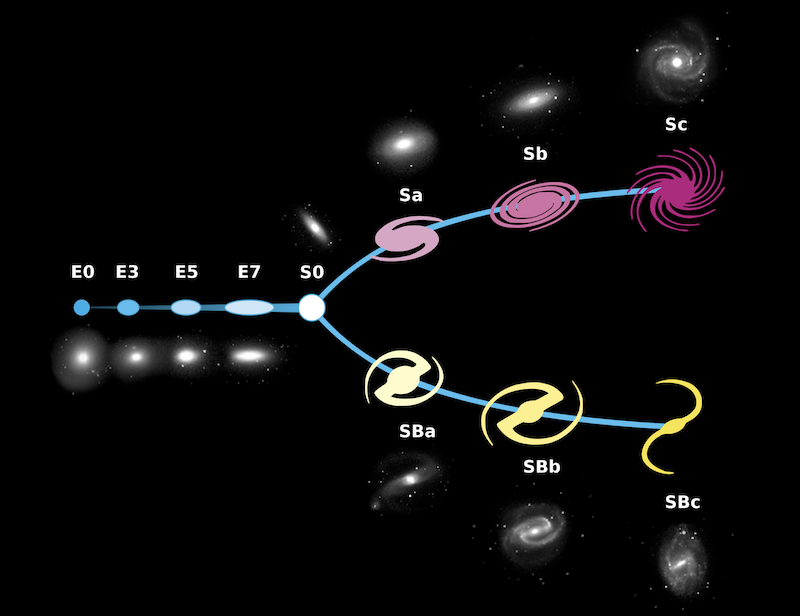
Elliptical galaxies are galaxies with little dust and gas left. Giant elliptical galaxies make up some of the largest galaxies in the Universe. By contrast, dwarf elliptical galaxies are frequently found circling larger spiral or elliptical galaxies.
Hubble’s system of classifying elliptical galaxies is not based on size, spectrum, or origin but rather on shape and structure (more commonly referred to as morphology). Completely spherical elliptical galaxies are referred to as E0 types, flattening out to more oval or American football-shaped galaxies as E1, E2, and so on all the way to E4. Hubble classified some galaxies that were thought to be elliptical all the way to E7, but we now know that those were just lenticular galaxies viewed at an odd angle. Hubble was also unaware of the differences between dwarf spheroidal/elliptical galaxies and their larger counterparts, which we’ll get into later.
Lenticular galaxies are sort of an intermediate class between elliptical and spiral galaxies and are classified as S0 or ES in the Hubble system. They have the spherical shape of elliptical galaxies at the center, surrounded by a disk of concentric rings of dust that can look like a spiral when viewed edge-on, or an elliptical galaxy if the disk is not very bright. Lenticular galaxies have little ongoing star formation, which you can see in images as the dust lanes lack any bright bluish or pinkish spots corresponding to young blue stars or hydrogen-rich star-forming regions. Lenticular galaxies are either aging spirals or the products of galaxy mergers; our own Milky Way and Andromeda galaxies could become lenticular galaxies when they merge a few billion years from now.
Spiral galaxies were thought in Hubble’s day to have evolved from elliptical and lenticular galaxies; today we know that they probably were some of the first galaxies with regular structure and that all giant elliptical and most lenticular galaxies are probably the results of mergers between smaller spiral galaxies. Spiral galaxies can be differentiated between barred spirals, which have a bar going through the center of the galaxy, and unbarred spirals, or SA and SB, respectively; some astronomers drop the A and refer to unbarred spirals as just S-type. Hubble also adds a letter to denote how tightly wound the spiral arms are, with a denoting the tightest and c the least tight, with later astronomers adding the d class for extremely loose spirals. Our own Milky Way is an SBc galaxy, while nearby Andromeda is an SAb galaxy, lacking a bar and with tighter spiral arms than our own.
Hubble lumped anything that did not fit into the other three categories into the irregular (Irr) category, with Irr I denoting galaxies with resolved star clusters and Irr II for those that did not have any resolved star clusters.
Hubble’s system is a bit incomplete and also somewhat subjective, which can lead to different people assigning different classifications to the same galaxy. It is still used today for many purposes, such as bulk classification of galaxies with the citizen science website Galaxy Zoo, where you can categorize scientific images of faint galaxies, helping scientists, and improving automated image-analysis tools. Many amateur astronomers also tend to stick to the Hubble system for reference purposes, as it is fine for describing the majority of galaxies.
Astronomer Gérard de Vaucouleurs added on to the Hubble system in 1959 with SaB to denote weak bars, R for ring galaxies, and a few other labels, which will be discussed later.
Yerkes Classification of Galaxies
Astronomer William Wilson Morgan created the Yerkes classification method for galaxies at the Yerkes Observatory in Wisconsin in the 1960s, along with a classification system for galaxy clusters.
The Yerkes system is similar to that of Hubble but adds characteristics of spectral analysis and a few new subtypes of galaxies. The Yerkes system is based purely on objective observations rather than subjective analysis, with some pros and cons as a result.
The first letter in the Yerkes classification system denotes what spectral color of star dominates the galaxy. Stellar spectral classification is alphabetical for the most part, with A stars being brighter and hotter than B and so on through K; confusingly, M stars are dim red dwarfs or massive red giants, but O stars are hotter than anything else, being added later. Thankfully, the Yerkes system only goes from A through K.
The second letter in the Yerkes system denotes the morphology of the galaxy. Morgan has the usual S spirals and E ellipticals, with I for irregulars. However, Morgan uses the letters B for barred spirals, D for rotational symmetry without spiral or elliptical structure, Ep for ellipticals with dust (and also, confusingly, for lenticular galaxies), L for low surface brightness, and N for a small bright nucleus. From an observational standpoint, this classification system can be a little confusing.
The last letter in the Yerkes system denotes the apparent inclination of the galaxy observed, similarly to how the Hubble system denotes the observed “flatness” (which may or may not actually be correct in some cases). Obviously, the apparent inclination isn’t applicable to irregular or elliptical galaxies and is thus not labeled, and the apparent angle doesn’t really say much about a galaxy other than our own perspective of it.
Bautz-Morgan Galaxy Cluster Classification
Morgan and another astronomer, Laura P. Bautz, also created a simple system for classifying galaxy clusters. Type I clusters contain a dominant or “anchor” galaxy much larger, brighter, and more massive than the others at the center; Type II clusters contain multiple giant galaxies that dominate the cluster compared to the rest in size and mass; and Type III clusters contain no exceptionally large or dominant galaxies.
Galaxy Types In The Modern Galaxy Classification
In this part of the article, we’re going to talk about the more comprehensive and easy-to-understand classification of galaxies known today and give you some examples of ones that can be seen in a telescope. Astronomers today use a combination of the Hubble and Yerkes systems as well as a purely literary system to classify galaxies, with no one system being completely standard or always applicable.
Most galaxies feature central black holes, and all but the smallest galaxies tend to have a halo of globular star clusters orbiting them.
1. Elliptical Galaxies (Hubble type E)
Elliptical galaxies, as their name implies, display a rounded or oval shape, distinct from the iconic spirals of galaxies like the Milky Way. The classification of elliptical galaxies has evolved over time. Edwin Hubble introduced a subclassification for ellipticals based on their apparent ellipticity, termed as ‘En’, where ‘n’ quantified the ellipticity on a scale from 0-7, with 0 being flat like a lenticular galaxy and 7 appearing almost perfectly round. More recent contributions include the Kormendy and Bender classification, which expands upon Hubble’s initial efforts, delving deeper into the structural nuances and providing more refined categorizations based on intricate observational data.
A unique characteristic of many elliptical galaxies is their complete rotational symmetry. Unlike their spiral counterparts, which demonstrate structured rotational patterns, most elliptical galaxies rarely exhibit features besides radially-symmetrical dust lanes. The most notable structures are typically their surrounding haloes of globular star clusters and any active jets produced by their central black holes.
Giant Elliptical Galaxies (cD)
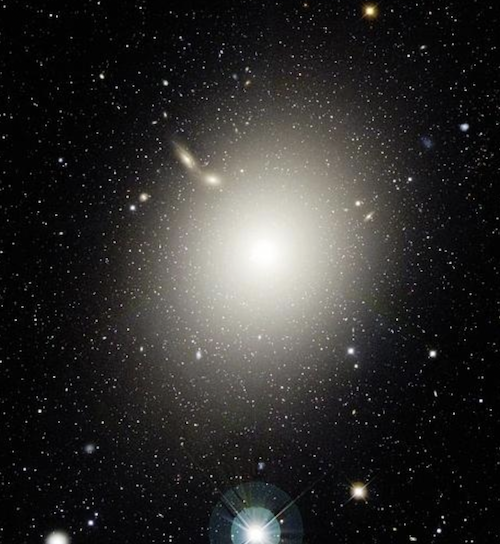
Giant elliptical galaxies are the largest galaxies in the Universe. They are the byproduct of many galaxy mergers, with an orange color due to their lack of star formation, the lack of remaining young blue or white stars, and the resulting composition of primarily orange or red stars. These stars are a mix of the low-mass, slow-burning red and orange dwarf stars, which have yet to exhaust their fuel even if they were born shortly after the beginning of the Universe, and the red giant stars, which used to be around the size of our own Sun but have exhausted their fuel and are beginning to die. Most giant ellipticals are very old and can be the anchors of galaxy clusters. Giant elliptical galaxies don’t have any significant patches of hydrogen gas (H-II regions) to form new stars and don’t contain young ones as a result. Most lack significant dust patches, too.
The cD designation of giant elliptical galaxies is a bit of a backronym, as it is not only a Yerkes classification but also refers to their central, dominant status in many galaxy clusters owing to their size and mass.
Giant elliptical galaxies almost always have supermassive black holes at their centers. These are the largest black holes in the Universe, with masses millions to billions times that of the Sun and event horizons larger than our entire Solar System. Some of these black holes are actively feeding on gas and dust, and when this material fails to fall into the black hole due to spin or magnetic forces, it will gravitationally “slingshot” around the black hole, causing it to absorb immense gravitational energy, heat up, and shoot out at near the speed of light in a beam-like superheated jet.
ESO 325-G004 stands out in the cosmic tapestry as a prime example of a giant elliptical galaxy. These behemoths occupy a significant space in the universe and are characterized by their enormous masses and lack of discernible structures like spiral arms. Located in the heart of the constellation Hydra, observations of this galaxy have played a pivotal role in confirming the presence of dark matter around massive galaxy clusters and its influence on the gravitational lensing effects of distant galaxies.
Giant elliptical galaxies you can see in a telescope
M87 is probably the most famous elliptical galaxy, lying about 53 million light-years away at the heart of the Virgo Cluster of galaxies. M87 can be seen in binoculars, and like many elliptical galaxies, it was thought to be a globular star cluster until it became evident that no ground-based telescope was powerful enough to resolve individual stars within, and its distance was ultimately measured. M87’s central supermassive black hole, named M87* or Powehi, was the first black hole to be directly imaged with the Event Horizon Telescope. Despite being 53 million light-years away, it actually subtends a similar angle in the sky to Sagittarius A*, the black hole at the center of our own Milky Way, on account of its mass; Powehi is 6.5 billion times the mass of our Sun versus a mere 4.4 million for Sagittarius A* and as such, it is about 1500 times larger in radius and only 2000 times further away.
Powehi is responsible for creating a massive superheated jet of gas that shoots out of M87, which is pretty much the only feature able to be visually observed with a telescope. Many reliable observations have been made of this jet with giant telescopes such as the 82” Otto Struve telescope and 30-40” Dobsonian telescopes, but confirmed reports with instruments as small as 12.5” exist, and it would seem that a 16-20” instrument should do it with the right observer and conditions (the author has not managed to see the jet yet). M87’s jet is very small in angular size and requires very high magnification (500–800x) to see, which makes observing it difficult. The jet can be imaged fairly easily with 8” or larger telescopes at a suitable image scale with a good camera.
M86 and M49 are near M87 in the sky, and M49 is surprisingly bright despite being smaller in size than M86 or M87. Both can be seen with a small telescope or binoculars.
The Coma B galaxy cluster in Coma Berenices, centered on NGC 4889 and NGC 4874, is home to many distant giant elliptical and lenticular galaxies hundreds of millions of light-years away. An 8-10” telescope shows NGC 4889, NGC 4874, and a couple of dozen faint fuzzies accompanying them, while a 12” or larger telescope can show up to a few hundred galaxies, even in a single field of view. NGC 4889 is one of the largest galaxies known, about a million light-years wide; for comparison, that’s half the distance between us and the nearby Andromeda Galaxy.
Compact Elliptical Galaxies (cE)
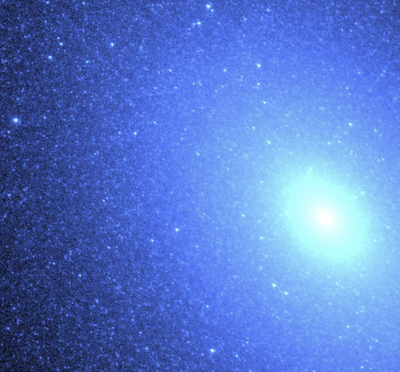
Compact elliptical galaxies are a relatively rare type of galaxy caused by spiral galaxies being stripped of their outer parts. One of the few examples of these is M32, a satellite galaxy next to the Andromeda Galaxy that is easily seen with 4” or larger telescopes. M32 was probably once a spiral galaxy, referred to as M32p, half as big as our own Milky Way or Andromeda galaxy and similar in size to nearby M33, the Triangulum Galaxy. It lost most of its outer layers in a close brush with Andromeda two billion years ago, which also triggered a rapid burst of star formation.
Dwarf Elliptical & Dwarf Spheroidal Galaxies (dEs & dSph)
On the other end of the size spectrum, we find dwarf elliptical and spheroidal galaxies, which share the roundish shape of giant elliptical galaxies but actually have fairly little else in common with their jumbo-sized doppelgangers.
These galaxies are usually small, old, and have very little gas and dust left, with little star formation occurring as a result. This also makes them dim, low in surface brightness, and hard to detect. They are usually named after constellations they are discovered in, and often span huge areas of the sky. Our own Milky Way galaxy is currently in the process of cannibalizing at least one dwarf spheroidal galaxy, and dozens orbit our galaxy and the nearby Andromeda Galaxy, though many are too faint to observe and have only been discovered fairly recently, with brightness less than that of many globular star clusters, and mass that is largely only higher on account of unusually high concentrations of dark matter.
Leo I, a member of the Local Group of galaxies, is a dwarf elliptical galaxy located in the Leo constellation, a mere 820,000 light-years from our Milky Way. These dwarf ellipticals, while much smaller in comparison to their giant counterparts, are essential in understanding the broader processes of galaxy formation and evolution. Leo I, with its relatively isolated position and older stellar population, offers a glimpse into the early universe and the primordial conditions that gave birth to such entities.
Dwarf elliptical and spheroidal galaxies you can see in a telescope
Our Milky Way galaxy is currently devouring the Sagittarius Dwarf Spheroidal Galaxy. The bulk of this galaxy is not really visible with amateur instruments, but its center is likely the globular star cluster M54, which is visible with most telescopes or binoculars and resolved into stars with a 6” or larger instrument. NGC 2419 is also visible with a 6” or larger telescope, resolved with 12” or more of aperture, and may or may not be part of the Sagittarius dSph along with a few other, fainter globular star clusters scattered around the night sky.
The Canis Major Overdensity is a possible dwarf elliptical galaxy that has been almost completely consumed by the Milky Way, forming a ring of stars and dust looping above and below the disk of the Milky Way. The globular cluster M79, visible with binoculars and small telescopes and resolved with an 8” or larger instrument, may be a part of this galaxy.
The Fornax Dwarf Spheroidal Galaxy is about half a million light-years away from us and invisible in amateur telescopes. However, NGC 1049, a globular cluster within the galaxy, is readily seen with a 10-12” telescope and was discovered well before the Fornax dSph itself. Observers with very dark skies and/or larger telescopes may be able to see a few more.
NGC 147 and NGC 185 are dwarf spheroidal galaxies orbiting the Andromeda Galaxy, about 2 million light-years away, which can be seen with a 6” or larger telescope a few degrees away from Andromeda itself in the night sky. Neither shows much detail, but they’re easy to find, and both can be viewed at the same time at low magnification.
The globular cluster Omega Centauri is only visible from latitudes south of about 38 degrees, but it is visible to the naked eye under clear conditions, and individual stars within show up in binoculars. It is absurdly bright even in modest telescopes, spanning an area of sky as wide as the full Moon, while 12” or larger instruments reveal a bluish color. Omega Centauri is probably the remnant of a dwarf elliptical or spheroidal galaxy like M54 or M79, and is one of the brightest and most massive globular clusters known, only beaten by the G1 globular cluster in the Andromeda Galaxy.
2. Spiral Galaxies (Hubble and Yerkes type S)
Dominating the cosmic landscape, spiral galaxies, accounting for up to a whopping 77% of all known galaxies, are the most common type of galaxy, though this is actually a relatively recently determined statistic. Their name stems from their iconic pinwheel structure, with arms that spiral outward from a central bulge.
Spiral galaxies are primarily defined by three components:
- Bulge or core: A central concentration of older stars, typically reddish in color.
- Disk or arms: A flat, rotating region encompassing spiral arms, rich in gas, dust, and younger stars.
- Halo: An almost spherical structure surrounding the galaxy, filled predominantly with dark matter, old stars, and globular clusters.
Further diving into the intricacies of spirals, we come across ‘barred’ spiral galaxies, characterized by a central bar-like structure. These are subclassified into Sba, SBb, and SBc based on the tightness of their spiral arms and the prominence of their central bar. In addition to these, there are Sc galaxies, which have more loosely wound arms and smaller bulges.
Most spiral galaxies have plenty of dust, star-forming H-II regions (nebulae), and young, energetic stars in their spiral arms. The cores of spiral galaxies contain older and thus yellower and redder stars, while halos of dozens or hundreds of globular star clusters orbit above and below the plane of the spiral arms. Most spiral galaxies have a bar of dust, gas, and stars bisecting their cores, while a minority do not. It is thought that unbarred spiral galaxies transition back and forth from barred spirals and vice versa as gas, dust, and new stars funnel in and out of the center of the galaxy.
Grand Design Spiral Galaxies (S/Sa)
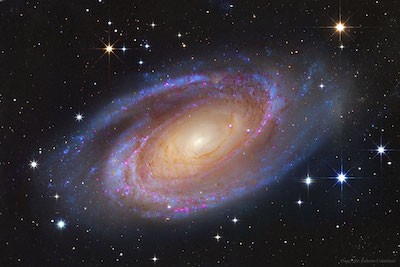
Spiral galaxies without a bar are well in the minority, making up less than a third of spiral galaxies. However, they are easily the most iconic in appearance.
Grand design spiral galaxies are usually what we think of when we picture spiral galaxies, especially unbarred ones, and the spiral galaxies fitting under type Sa are of this classification.
Grand Design spiral galaxies you can see in a telescope
- M81 is a great example of a Grand Design spiral galaxy, with prominent, S-shaped arms and a weak dust lane near the center. Its core is bright and easily seen from the suburbs with even a 4” telescope, but the spiral arms are visible only under fairly dark skies free of light pollution, with an 8” or larger telescope. Nearby M82 is a starburst galaxy with more easily-viewed detail, which we’ll get to later. Together, the two galaxies are easily seen in binoculars almost anywhere, and faintly visible to the naked eye under extremely dark skies.
- M101, the Pinwheel Galaxy, features prominent H-II regions (star-forming nebulae), which even have their own catalog designations. The spiral arms require dark skies, low magnification, and patience to see, but are fairly readily seen with a 6” or larger instrument.
- M74 is known as the “Phantom Galaxy,” but can be seen with a 6-8” telescope under fairly dark skies, with the spiral arms popping up with 8-10” or larger telescopes under careful observation.
Intermediate Spiral Galaxies (SAB)
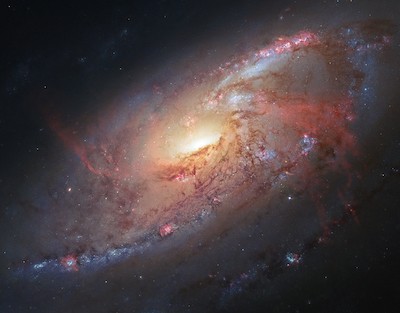
Intermediate spiral galaxies have a bar at the center, but the bar might only be denoted by the presence of dust and lack a bright component to it, or it simply isn’t very high in contrast to begin with. Intermediate spirals may be transitioning between being barred and unbarred spiral galaxies.
Intermediate spiral galaxies you can see in a telescope
- M65 & M66 make up ⅔ of the “Leo Trio” of prominent galaxies in Leo and are similar in size and position to our own Milky Way and Andromeda galaxies, though with weaker bars at their centers. Both can be seen with a 4” or larger telescope, with 8-10” telescopes bringing out dust lanes in both galaxies.
- M83 is a very bright galaxy visible with binoculars in the southern sky with a bar that’s readily seen in a 6” telescope, though the bar is not dramatically brighter than the disk or tight spiral arms of the galaxy.
- M106 has a bright and puffy outer disk, with unusual spiral arms full of large wispy clouds of hydrogen. Its dust lanes and outer disk are visible with 8” or larger telescopes.
Barred Spiral Galaxies (Sb)
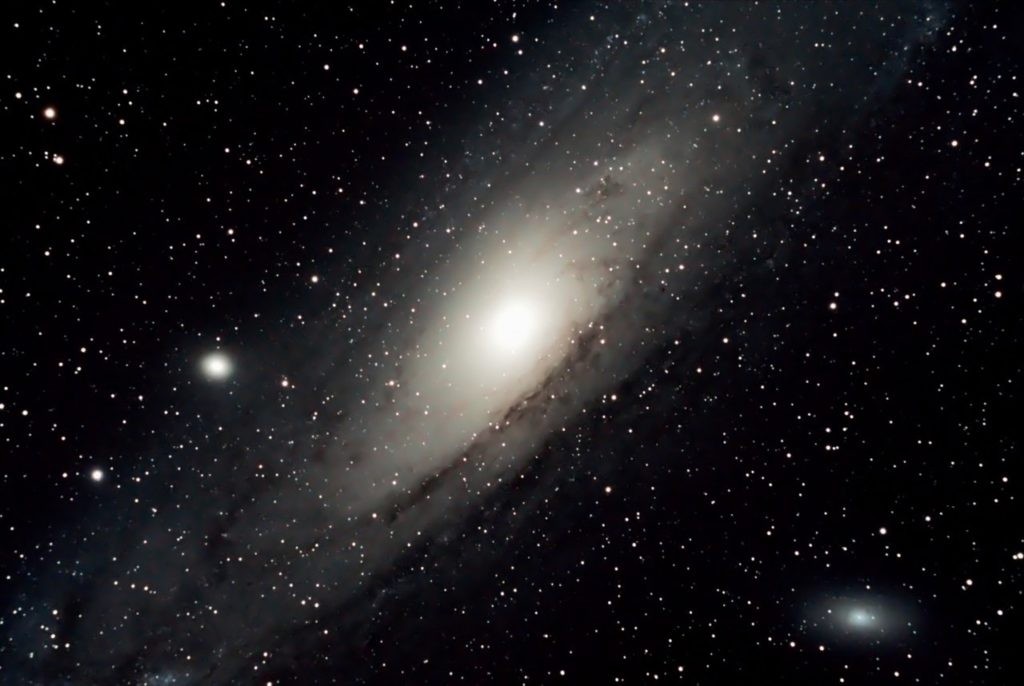
Spiral galaxies with a bar of some kind make up the majority of galaxies in the Universe, including our own Milky Way galaxy. Sb type galaxies with a bright bar are a little less common than intermediate spirals, however.
Barred spiral galaxies you can see in a telescope
- M31, the Andromeda Galaxy, is of course visible to the naked eye from suburban or dark skies, or with binoculars and telescopes anywhere. It has rich dust lanes, satellite galaxies, and tight spiral arms which can be seen with larger instruments. However, the bar in M31 is not very easy to see because we are staring straight down the middle of it.
- M109’s tight spiral arms and bar are hard to see with a small telescope, but 8” or more of aperture brings them out.
- NGC 1300 and NGC 1365 are both examples of spectacular barred spirals further south in the sky, though you’ll want 10-12” of aperture to see them at their best. A very large telescope with 14” or more aperture shows their spectacular S shapes like no other.
Flocculent Spiral Galaxies (Sd)
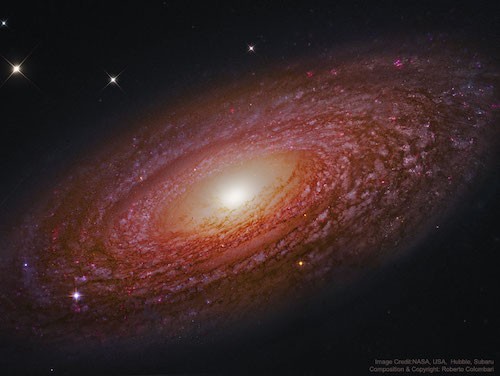
Flocculent spiral galaxies have spiral arms that do not reach the center of the galaxy or are otherwise discontinuous in some way. Interstellar shock waves within these galaxies clear away parts of the spiral arms, which may or may not eventually reconstitute themselves.
Flocculent spiral galaxies you can see in a telescope
- NGC 2841 is the archetypical example of flocculent spirals and also the brightest and easiest to see, best visible in telescopes of 8” or larger aperture but appearing in binoculars under dark skies. An 8” or bigger telescope brings out its “fluffy” appearance.
- NGC 2775’s dimmer outer disk and bright core can be seen with 8” or larger telescopes; 12” or more aperture is needed to resolve the arms clearly, which look more like a disk with holes than anything.
- NGC 1325 is another great example of a flocculent spiral, with lots of dark dust visible in 8” or larger instruments.
Magellanic Spiral Galaxies (Sm)
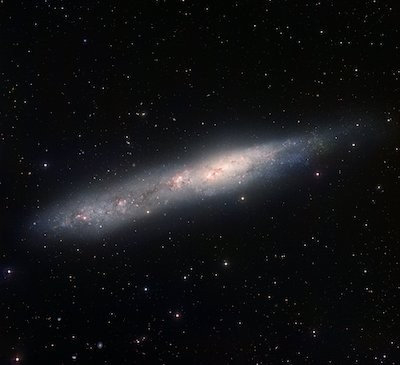
Magellanic spiral galaxies are named for the Large Magellanic Cloud, a galaxy visible from the Southern Hemisphere which they resemble and one of the closest to our own Milky Way. Magellanic spiral galaxies have a distorted single spiral arm and often a bar at the center.
Magellanic spiral galaxies you can see in a telescope
- NGC 55 is only 6.5 million light-years away from us and shows spectacular star clouds and H-II regions in even a modest telescope, provided it is high enough above your southern horizon to see (for Northern Hemisphere observers).
- NGC 5474 is a snail-shaped Magellanic spiral next to M101, distorted due to interactions with it. A 10” or 12” telescope is best for seeing it well.
- NGC 4236 is a faint and low-contrast galaxy belonging to the same galaxy group as M81 and M82, with a bar near the center. Dark skies, low magnification, and preferably at least 8-10” of aperture are needed to see it well.
3. Lenticular Galaxies (Hubble S0/ES, Yerkes Ep)
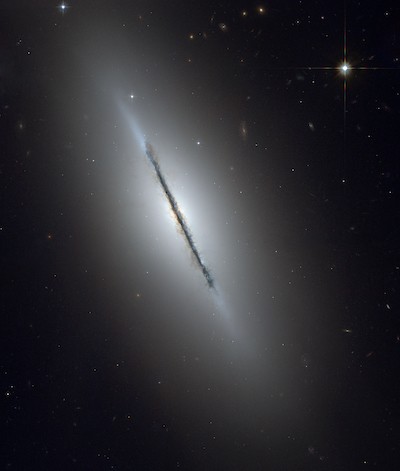
Lying in the interstice between the grand spirals and the near-uniform ellipticals, we encounter the lesser-known but equally captivating lenticular galaxies. These celestial objects bear witness to the intricate dance of cosmic evolution, offering hints of both spiral and elliptical characteristics, thus serving as a transitional bridge in the vast universe.
At first glance, lenticular galaxies, classified as type S0 in Hubble’s galaxy taxonomy, might be mistaken for ellipticals due to their lens-like appearance. However, upon closer inspection, one will notice a disk structure, similar to spirals, but without the signature spiral arms. They blend the old, redder stellar populations typically found in elliptical galaxies with the flat disk characteristic of spiral galaxies. Yet, they largely lack the gaseous substance needed for new star formation, making them appear somewhat devoid of the vibrant young stars that adorn their spiraling counterparts.
Lenticular galaxies are some sort of transitional state between spiral and elliptical galaxies. The exact process that creates lenticular galaxies remains a topic of debate among astronomers. Some theories suggest they may evolve from spiral galaxies that have undergone specific processes, such as gravitational interactions with other galaxies or the loss of interstellar matter, which deplete their star-forming gas. Others propose that they might be the result of a merger between galaxies, leading to a reshuffling of stars and the gas being used up or expelled. Lenticular galaxies can get spectacularly large, much like giant ellipticals, and are easily mistaken for elliptical galaxies. Lenticular galaxies may still have bluish disks but are not undergoing significant star formation and lack prominent H-II star-forming regions.
Despite their elusive nature, studying lenticular galaxies is crucial for understanding galactic evolution. They offer clues about the potential future of spiral galaxies, including our own Milky Way, as they exhaust their star-forming materials. Furthermore, their intermediate position in the galaxy spectrum provides insights into the broader cosmic narrative, from the energetic days of youth to the quietude of maturity.
Lenticular galaxies you can see in a telescope
- M102 (NGC 5866) is seen only from edge-on to us, but has a spectacular needle-like disk with a dark dust lane.
- NGC 1023’s bright center and dimmed outer halo are fairly conspicuous with an 8” or larger telescope.
- For those looking for a challenge, IC 1101 is one of the largest galaxies in the universe, spanning around a million or so light-years wide and nearly a billion light-years away. It can be seen with a 12” or larger instrument under dark skies.
4. Irregular Galaxies (I or Ir)
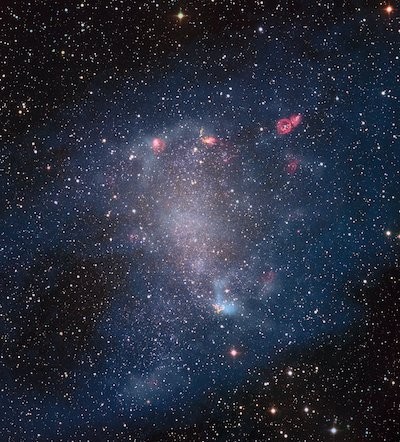
Irregular galaxies tend to have at least something vaguely resembling a former spiral structure, though the most bizarre are unfortunately not visible with amateur telescopes. As their name suggests, irregular galaxies don’t conform to the typical shapes and structures found in their more organized counterparts. With lower masses and luminosities than spiral galaxies, these galaxies might seem underwhelming at first glance. However, their rarity (comprising just about 3% of known galaxies) and unique characteristics make them immensely significant in the world of astronomy.
Irregular galaxies can be further categorized into three primary types: Irrl (Irr1), Irrll (Irr2), and Dlrr lll. These classifications arise from their specific properties and appearances, with some demonstrating a slight hint of structure while others appear entirely chaotic.
A noteworthy example of irregular galaxies is the Small Magellanic Cloud, easily seen with the naked eye from the Southern Hemisphere. This satellite galaxy of our Milky Way is of particular interest to astronomers due to its star formation characteristics. Irregular galaxies like the Small Magellanic Cloud house a mix of young, hot population I stars and older, cooler population II stars. This blend provides crucial insights into the life cycles of stars and the evolution of galaxies over time.
Irregular galaxies you can see in a telescope
- NGC 6822, Barnard’s Galaxy, is one of the closest observable galaxies to us besides the Magellanic Clouds, at 1.6 million light-years away. It has a few bright H-II regions that are visible in 10” or larger telescopes and photographs show the remnants of a bar structure.
- NGC 4449, the Box Galaxy, features similar massive star-forming regions and evidence of a weak central bar to NGC 6822 and is slightly more concentrated. 12” or larger telescopes show its H-II regions.
5. Peculiar or Interacting Galaxies (P)
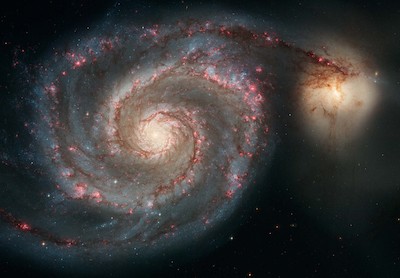
Venturing further into the unique, we encounter the peculiar or interacting galaxies, aptly named for their irregular and often chaotic appearances. Accounting for 5 to 10 percent of all known galaxies, these celestial objects are not born odd; they become so almost always as a result of dramatic galactic collisions. When galaxies merge or come into close proximity, gravitational forces can distort their shapes, leading to the formation of tails, rings, or other unexpected structures. These cosmic crash sites are treasure troves for scientists, providing valuable insights into the dynamics of intergalactic interactions and the future of our own galaxy. “Peculiar galaxies” is an old term for unusual galaxies that were created as a category by Halton Arp. Arp ended up studying many prominent interacting galaxies over his career, and his Atlas of Peculiar Galaxies contains many examples of interacting galaxies. Interacting galaxies are any galaxies that are undergoing a close pass or merger, which distorts their shape and can create odd features like tidal streams of gas and stars.
Interacting galaxies you can see in a telescope
- M51, the Whirlpool Galaxy, is, of course, a great example of a spiral galaxy, with arms visible in larger telescopes. It is merging with the smaller irregular galaxy NGC 5195, which brushes up against the end of one of its arms and can be seen next to the core of M51 itself with a small telescope or binoculars.
- NGC 4656/7, the Hockey Stick galaxy, is a hook-shaped former barred spiral merging with a much smaller companion. It looks great in 6-8” or larger telescopes, and is near a distorted edge-on spiral galaxy known as the Whale, which may also be responsible for the Hockey Stick’s distorted shape.
- NGC 4490/4485, the Cocoon Galaxy, is a pair visible with 8” or larger telescopes as a hook-shaped fuzz just above the bright star Adhara. Like the Hockey Stick, this is an example of a large spiral consuming a smaller one, with distortion as a result.
- The Antennae Galaxies (NGC 4038/39), aptly named for their appearance in photographs or large telescopes, can be glimpsed with small instruments, but a 10” or larger telescope at high magnification is required to see their comma or squiggle shapes.
6. Starburst Galaxies
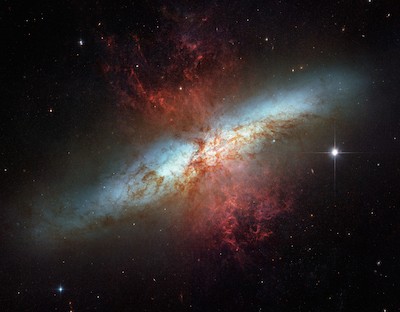
Starburst galaxies have dramatically high rates of star formation, often caused by close encounters or mergers with other galaxies. Many interacting galaxies tend to turn into spiral galaxies, and most starburst galaxies are primarily classified as some other type. Starburst galaxies near us make up some of the brightest galaxies in the night sky on account of their high volume of young and bright blue supergiant stars.
Starburst galaxies you can see in a telescope
- NGC 253, the Sculptor Galaxy, is also an intermediate spiral galaxy and one of the brightest in the night sky, easily seen in binoculars or with small telescopes. Evidence of its H-II regions and a bluish tint are visible in larger instruments.
- M82, the Cigar Galaxy, is five times brighter than the Milky Way but only about a quarter as big. It is visible in binoculars, and even a 4” telescope shows its huge hydrogen filaments, which jut perpendicularly across the galaxy, extending out like flames in photographs. M82 still has faint evidence of spiral arms, but was torn apart during a close pass with its spiral neighbor, M81, triggering its starburst activity and creating the perpendicular filaments. M82 also has frequent supernovae, with the last one occurring in 2014.
- Centaurus A (NGC 5128) is a lenticular or elliptical galaxy, but also a starburst galaxy, and the nearest giant elliptical or lenticular galaxy to us. It is clearly the product of a merger of some sort, with at least one spiral galaxy involved. Evidence for this includes its starburst activity combined with a bizarre dust lane visible even in small telescopes and giant gaseous lobes/jets from its central black hole, as seen in photographs. Centaurus A is far south in the sky and may be near the horizon from northern latitudes, but it is thankfully easy to spot even with binoculars.
7. Ring or Hoag Galaxies
Ring galaxies have yellow, old cores with little to no star formation, gas, or dust, and blue rings full of energetic gas and young stars separated from the core. They probably form when small galaxies pass through the centers of larger elliptical galaxies, forming a ring system just like Saturn’s rings formed when a moon passed too close to it eons ago.
Named after its most famous representative, Hoag’s Object, a Hoag-type galaxy is characterized by a core of older, redder stars surrounded by an outer ring of younger, bluer stars with an apparent gap in between. This striking configuration, resembling a cosmic bullseye, has left astronomers both intrigued and baffled. The mechanics behind the formation of these galaxies are still the subject of debate. Some theories suggest a rare collision between galaxies might have led to this unique design, while others believe it may result from specific internal evolutionary processes.
The galaxy PGC 1000714 stands as a prime example of this rare class. Situated roughly 359 million light-years away, this galaxy offers more than just the standard Hoag-type structure. In fact, PGC 1000714 boasts not one but two outer rings, making it an even rarer specimen. Its central body is accompanied by a faint blue outer ring and an even fainter second ring. The presence of the second ring adds another layer of mystery, challenging our already shaky understanding of these cosmic anomalies.
Unfortunately, no ring galaxies are close enough or bright enough to be observed with amateur telescopes.
8. Ultra-Diffuse Galaxies (L)
Ultra-diffuse galaxies contain very little of anything at all, with low densities of stars, few bright or massive stars, few clusters, and little gas or dust. They seem to be anchored together by dark matter and have only been discovered fairly recently, owing to their small size and faintness. They can have a size and mass similar to that of the Milky Way galaxy owing to their dark matter-heavy composition, but only 1% as many stars as our own galaxy does. Some ultra-diffuse galaxies have globular clusters.
Ultra-diffuse galaxies are simply too faint and spread out to be observed with any visual instrument, and even taking photographs of them is quite difficult.
